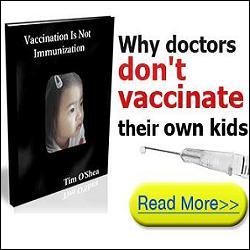Number of Chemicals Known To Be Toxic To Children’s Brains Has Doubled In The Last 7 years
Neurodevelopmental disabilities, including autism, attention-deficit hyperactivity disorder, dyslexia, and other cognitive impairments, affect millions of children worldwide, and some diagnoses seem to be increasing in frequency. The review published in The Lancet Neurology journal, says the news is so troubling they are calling for a worldwide overhaul of the regulatory process in order to protect children’s brains.
“We know from clinical information on poisoned adult patients that these chemicals can enter the brain through the blood brain barrier and cause neurological symptoms,” said Dr. Philippe Grandjean.
“When this happens in children or during pregnancy, those chemicals are extremely toxic, because we now know that the developing brain is a uniquely vulnerable organ. Also, the effects are permanent.”
Widget not in any sidebars
Dr. Philip Landrigan at Mount Sinai School of Medicine in New York and Dr. Philippe Grandjean from Harvard School of Public Health in Boston, authored the review.
Those five are lead, methylmercury, arsenic, polychlorinated biphenyls, or PCBs, and toluene.
People are exposed to methylmercury primarily through their diet, especially through the consumption of fish and other marine species, as well as through the consumption of rice when it is grown in a methylmercury-rich environment. People may be exposed to elemental or inorganic mercury through inhalation of ambient air during occupational activities and from dental amalgams.
Research from the Environment International Journal showed thatwomen with higher levels of mercury exposure are more than twice as likely to have elevated levels of antibodies that are associated with autoimmune disorders such as arthritis and lupus.
In sufficient doses, methylmercury can affect the developing nervous system in the developing fetus and in growing children. In adults, elevated methylmercury exposure can lead to neurological problems, such as memory loss and tremors. Recent studies show thatmethylmercury exposures can also lead to cardiovascular and immune effects.
Vaccines A Major Source of Toxicity
Vaccines have been particularly problematic for introducing toxins into children. Despite thimerosal (a mercury-based preservative) being banned by the FDA, 60% of all flu vaccines still contain this deadly neurotoxin. The following scientific publications document the adverse effects of mercury, merthiolate and ethyl mercury.
Thimerosal, is metabolized (converted) into the toxic and “harmful” methylmercury. And then in turn, the harmful methylmercury is metabolized (converted) into the most harmful, long-term-toxic, “inorganic” mercury that is retained in bodily tissue.
“Inorganic” mercury is the end product of mercury metabolism. Methylmercury subject groups confirm that the metabolic pathway for mercury in the human and animal body consists in the reduction/conversion of the harmful methylmercury into a more harmful “inorganic” mercury which is tissue-bound, and long-term-toxic. Hence, both the originating substance (methylmercury) and its conversion/reduction, inorganic mercury are found.
Based on published findings by Dr. Paul King, the metabolic pathway for organic mercury involves the conversion of Ethylmercury (Thimerosal) into “methylmercury” and then the further reduction of “methylmercury” into inorganic mercury.
At greatest risk? Pregnant women and small children, according to Grandjean. According to the review, the biggest window of vulnerability occurs in utero, during infancy and early childhood.
Arguably one of the most outspoken and articulate leaders in raising awareness on the dangers of vaccination, Dr. Russell Blaylock, MD,provides compelling arguments why the vaccination of pregnant women is harmful and a hidden cause of neurological disorders.
Six More Chemicals Added To List
After further review, the authors have added six more chemicals to the list: manganese; fluoride; tetrachloroethylene, a solvent; a class of chemicals called polybrominated diphenyl ethers, or flame retardants; and two pesticides, chlorpyrifos, which is widely used in agriculture, and dichlorodiphenyltrichloroethane, or DDT.
 “The continuing research has identified six new chemicals that are toxic to the developing human brain,” said Landrigan. “We’re turning up chemicals at the rate of about one a year that we’re discovering are capable of damaging the developing brain of a human fetus or human infant.”
“The continuing research has identified six new chemicals that are toxic to the developing human brain,” said Landrigan. “We’re turning up chemicals at the rate of about one a year that we’re discovering are capable of damaging the developing brain of a human fetus or human infant.”
To examine fluoride, which is in tap water in many areas, Landrigan and Grandjean looked at an analysis of 27 studies of children, mostly in China, who were exposed to fluoride in drinking water at high concentrations. The data, they said, suggests a decline on average of about seven IQ points.
Although advocates of fluoride say its use in munipal water systems poses no adverse health concerns, results from investigations clearly state the opposite. There has been considerable research done on fluoride regarding cancer, birth defects, and risks to the respiratory, gastrointestinal, and urinary systems, however, very little has been done on its neurological effects.
There’s another big concern: “We are very worried that there are a number of other chemicals out there in consumer products that we all contact every day that have the potential to damage the developing brain, but have never been safety tested,” Landrigan said.
“Over the last six or seven years we are actually adding brain toxic chemicals at a greater speed than we are adding toxicity evidence in children’s brains,” Grandjean said.
Maggie MacDonald, toxic program manager at Toronto-based Environmental Defence, says the study is particularly troubling because of:: “How prevalent these chemicals are in our environment, our homes and our bodies. Babies are being exposed to pollutants before they are even born,” says MacDonald, whose organization did a recent study testing umbilical-cord blood of newborns and found lead, methylmercury, pesticides, PCBs and PFCs (chemicals found in non-stick coatings), among other toxins. “This is a very serious problem that needs to be dealt with urgently, for the sake of children everywhere.”
Dr. Barry Blakley, a toxicology professor at the University of Saskatchewan, agrees that industrial chemicals’ effects on the brain need to be regulated in a far more stringent way. “The fetus is uniquely susceptible to developmental disorders…that can lead to immune and behavioural disorders, as well as reproductive dysfunction later in life,” Blakley said. “Often the effects are associated with low-level chemical exposure during pregnancy.”
“At least 1,000 chemicals using lab animals have shown that they somehow interfere with brain function in rodents — rats and mice — and those are prime candidates for regulatory control to protect human developing brains. But this testing has not been done systematically.”
There is a growing problem of pollution by toxins that affect hormonal systems. The water supply, for instance, has become polluted with some of the 30,000-100,000 chemicals used commercially, as well as by pharmaceutical drugs and prescription hormones like HRT, birth control pills, and growth hormones for farm animals. These areaffecting secondary sexual characteristics in boys.
“Beyond IQ, we’re talking about behavior problems — shortening of attention span, increased risk of ADHD,” Landrigan said.
“We’re talking about emotion problems, less impulse control, (being) more likely to make bad decisions, get into trouble, be dyslexic and drop out of school. … These are problems that are established early, but travel through childhood, adolescence, even into adult life.”
It’s not just children: All these compounds are toxic to adults, too. In fact, in 2006 the pair documented 201 chemicals toxic to the adult nervous system, usually stemming from occupational exposures, poisonings and suicide attempts.
Landrigan and Grandjean now say all untested chemicals in use and all new chemicals should be tested for developmental neurotoxicity.
This is not a new concept. In 2007, the European Union adopted regulations known as REACH — Registration, Evaluation, Authorisation and Restriction of Chemicals — to protect human health from risks posed by chemicals. REACH covers all chemicals, placing the burden of proof on companies to prove that any chemicals they make are safe.
“We are behind right now and we’re falling further behind,” Landrigan said. “… I finditvery irritating some of the multinational manufacturers are now marketing products in Europe and the U.S. with the same brand name and same label, but in Europe (they) are free of toxic chemicals and in the U.S. they contain toxic chemicals.”

The best example of this, he said, is cosmetics and phthalates. Phthalates are a group of chemicals used in hundreds of products from cosmetics, perfume, hair spray, soap and shampoos to plastic and vinyl toys, shower curtains, miniblinds, food containers and plastic wrap.
You can also find them in plastic plumbing pipes, medical tubing and fluid bags, vinyl flooring and other building materials. They are used to soften and increase the flexibility of plastic and vinyl.
In Europe, cosmetics don’t contain phthalates, but here in the United States some do.
Phthalates previously were used inpacifiers, soft rattles and teethers. But in 1999, after a push from the U.S. Consumer Product Safety Commission, American companies stopped using them in those products.
“We certainly have the capability, it’s a matter of political will,” Landrigan said. “We have tried in this country over the last decade to pass chemical safety legislation but the chemical industry and their supporters have successfully beat back the effort.”
“It’s not clear what effect, if any, phthalates have on human health,” according to the FDA’s website. “An expert panel convened from 1998 to 2000 by the National Toxicology Program (NTP), part of the National Institute for Environmental Safety and Health, concluded that reproductive risks from exposure to phthalates were minimal to negligible in most cases.”
But Grandjean is unfazed.
“We know enough about this to say we need to put a special emphasis on protecting developing brains. We are not just talking about single chemicals anymore. We are talking about chemicals in general.”
“We have the test methods and protocols to determine if chemicals are toxic to brain cells. If we look at this globally, we are looking at more than a generation of children — a very high proportion of today’s children have been exposed to lead, mercury and other substances, including substances that have not yet been tested but are suspect of being toxic to brain development.”
The Environmental Working Group is an environmental health research organization that specializes in toxic chemical analysis and has long called for reforms. In 2004, the group tested 10 samples of umbilical cord blood for hundreds of industrial pollutants and found an average of 200 in each sample.
“Here in the U.S., the federal law put in place to ostensibly protect adults and children from exposures to dangerous chemicals, including those that can present serious risks to the brain and nervous systems, has been an abject failure,” said Environmental Working Group spokesman Alex Formuzis.
“The 1976 Toxic Substances Control Act has instead been largely responsible for the pollution in people beginning in the womb, where hundreds of industrial contaminants literally bathe the developing fetus.”
Landrigan is recruiting pregnant women for a new study that will test for chemical exposures. He said it’s inevitable that over the next few years more chemicals will be added to the list.
His concern? “The ability to detect these chemicals lags behind the chemical industries’ ability to develop new chemicals and put them into consumer products. That’s why we need new legislation in this country to close that gap.”
“We are lagging behind,” Grandjean said. “And we are putting the next generation of brains in danger.”
Sources:
dr-king.com
theglobeandmail.com
cnn.com
vaccineliberationarmy.com
mercury-freedrugs.org
Dave Mihalovic is a Naturopathic Doctor who specializes in vaccine research, cancer prevention and a natural approach to treatment. He writes for Prevent Disease where this article first appeared.




